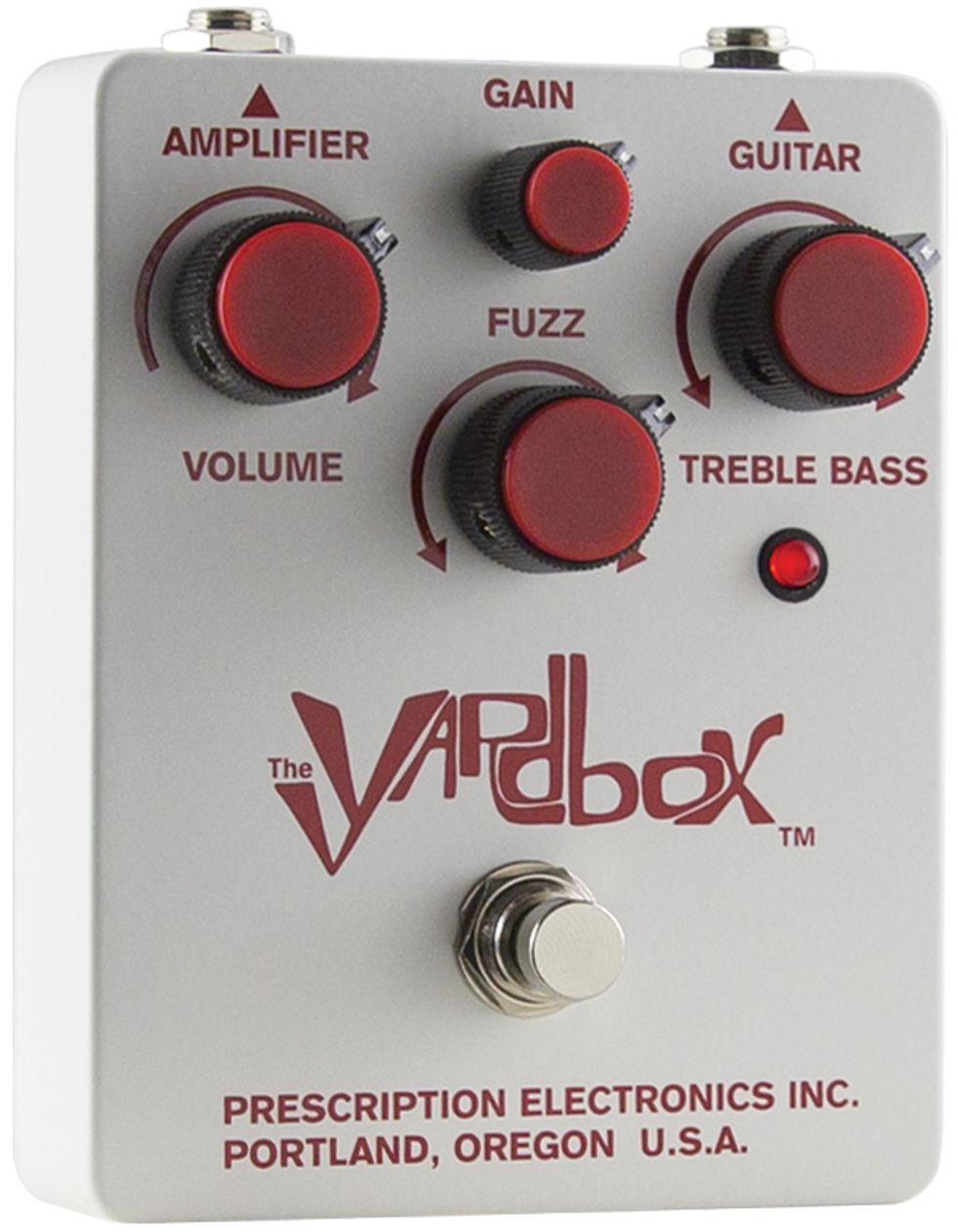RatingsPros:Vicious, resonant, rich, and complex Tone Bender voice. Highly interactive controls. Unusually large range of distortion and fuzz shades. Cons: Not as responsive to guitar volume attenuation as a germanium Tone Bender should be. Street: $199 Prescription Electronics Yardbox prescriptionpedals.com | Tones: Ease of Use: Build/Design: Value: |
I was excited when I first saw ads for the original ’90s Prescription Electronics Yardbox. I was a certified Yardbirds nut, but not yet versed in the iterations and evolutions of ’60s fuzzes. I had also been traumatized by a dream-shattering trip to the old Starving Musician in Santa Clara, where I jumped at the chance to play an old Rickenbacker, a ’60s solid-state Vox stack, and a late-’60s JEN-built Vox Tone Bender. I plugged in, turned up, and expected to grow ten feet and flash lightning like an ace-face Jeff Beck. Instead, I was mortified. It sounded like garbage.
The kindly shop minder assured me that old Tone Benders were a handful, that the pedal I tried wasn’t a very good one, and that I did myself no favors playing through the dust-encrusted Vox Buckingham, or whatever it was. Still, I was crestfallen—until I heard rumors that a Yardbox was a more stable update of those old Tone Benders. When I got my hands on one, I thought, I’d ascend to Beck’s and Page’s fuzzy heights.
In the decades since, I’ve tried a ton of Tone Bender clones and even a few very nice originals. So I’m happy to report that this newest Yardbox from the resurrected Prescription Electronics more than channels the menace and ferocity of the original. And while it’s not a transistor-for-transistor, knob-for-knob reproduction of a vintage Tone Bender, its enhanced control set lends the pedal a malleability that doesn’t compromise the rebellious spirit of ’66.
A Bird in Name …
While the Yardbox is most closely related to a Sola Sound MkII Tone Bender, it isn’t an exact reproduction. Then again, the Yardbirds aren’t strictly associated with the MkII. Jeff Beck used a two-transistor Tone Bender MkI for early fuzz excursions like “Heart Full of Soul.” But that pedal had more in common with the Maestro Fuzz-Tone than the three-transistor MkII. Beck, in fact, didn’t use a MkII with the Yardbirds until 1966, by which time his buddy Jimmy Page was onboard. So if you want to be a stickler, you could call this a Yardbirds MkII-inspired MkII Yardbox.
Historical minutiae aside, if you lift the hood on the Yardbox, its Tone Bender MkII origins fast become clear. Three telltale new-old-stock RCA germanium can transistors are grouped on the compact through-hole circuit. To the best of my knowledge, these RCA transistors weren’t used in vintage Tone Benders, but they are well regarded by other well-known boutique fuzz builders. In the unlikely event you don’t like what you hear from the RCAs, Prescription builds the Yardbox with transistor sockets so you can switch transistors without soldering. The primary board is affixed to the enclosure independently of the I/O jacks and footswitch. It’s also home to an output buffer switch that enables toggling between vintage-correct or buffered mode.
By bonehead vintage standards, the Yardbox’s controls are complex. MkI Tone Benders had volume and gain controls; MkII Tone Benders added a tone control. The Yardbox, though, has an additional gain control. Given that “fuzz” and “gain” are usually used interchangeably to describe Tone Bender functionality, it’s a touch confusing at first. In practical and expressive terms, however, it works beautifully and intuitively.
Full Fuzz Flight
Mastering the gain control takes practice and experimentation. But it’s fun and creative practice rather than a rigorous exercise, and the process of discovery highlights the Yardbox’s broader-than-vintage palette. While a gain control usually implies addition of volume and distortion, the Yardbox gain control also adds bottom-end mass and a pleasingly blurry compression. It also works interactively with the fuzz and tone controls to extend the range of both.
Most old Tone Benders are near-binary propositions at full guitar volume: blazingly fuzzy, maybe a touch of slightly less fuzzy, or off. But when you set the Yardbox’s gain control right you can extract cool mid-gain sounds and even mysterious, hazy near-overdrive tones at minimum fuzz settings. You can also use the tone and gain controls together to create varied, complex shadings from white-hot, pure-treble attack, to doomy Stooges-meets-Sabbath grind. The latter setting showcases the Yardbox’s uncommon capacity for articulating chord detail. In that respect in particular, it’s a rare bird indeed.
If the Yardbox has one drawback, it’s that it’s less than responsive to guitar volume attenuation, which is typically a virtue of germanium fuzz. To be fair, such dynamism was never the MkII Tone Bender’s strongest suit, at least relative to a germanium Fuzz Face. Still, it was difficult to extract anything approaching cleanish tones. Stratocaster single-coils and humbuckers delivered the most ringing tones at reduced guitar volume. P-90 tones, meanwhile, were brash and clipped. But even the cleanest tones among these were more like fuzzy overdrive than anything you would call jangly.
The Verdict
Though the Yardbox wears its Tone Bender pedigree boldly, there are enough additional colors available to make it feel like something much more versatile and unique. That doesn’t mean it fails to sound every bit as buzzy and bratty as you want a Tone Bender to be. But there is a much greater sense of control here than you feel in vintage units. And it communicates complex harmonic pictures in more detail than old Tone Benders. It’s an expensive pedal, but as far as classic fuzz circuits go, the Yardbox is as useful and satisfying an evolution as you’ll hear.








![Rig Rundown: Russian Circles’ Mike Sullivan [2025]](https://www.premierguitar.com/media-library/youtube.jpg?id=62303631&width=1245&height=700&quality=70&coordinates=0%2C0%2C0%2C0)

















